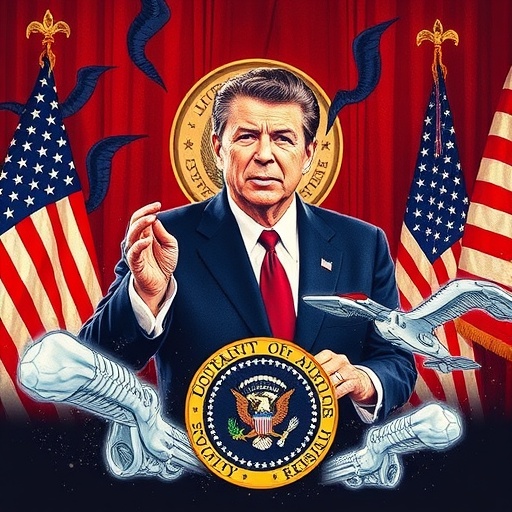Reagan‘s Ghost Haunts Trump Presidency: How the Gipper’s Legacy Shapes Oval Office Decisions
In the hallowed halls of the Oval Office, where presidents past and present have etched their marks on history, Donald Trump’s administration finds itself under the unmistakable shadow of Ronald Reagan. As Trump navigates his presidency amid economic turbulence and geopolitical tensions, political analysts point to Reagan‘s enduring presidential legacy as a guiding—and sometimes haunting—force. From tax reforms echoing the 1980s to a combative stance on international trade, Reagan’s political influence continues to loom large, shaping policy choices that could define Trump’s tenure.
- Tax Cuts and Deregulation: Reviving Reaganomics in the Trump White House
- Border Walls and Global Stance: Reagan’s Foreign Policy Echoes in Trump’s Worldview
- Rhetorical Fireworks: How Reagan’s Communication Style Fuels Trump’s Tweets
- GOP Heartland Hold: Reagan’s Base-Building Tactics in Trump’s Political Arsenal
- Future Shadows: Reagan’s Legacy and the Path Ahead for American Conservatism
This spectral presence isn’t mere nostalgia; it’s a calculated invocation. Trump, who has openly admired Reagan as the gold standard of Republican leadership, has drawn parallels in speeches and strategies, invoking the “Gipper” to rally his base. Yet, experts warn that while Reagan’s blueprint offers inspiration, the modern landscape—with its social media frenzies and global pandemics—presents pitfalls that could amplify or undermine this Trump presidency. A recent Pew Research Center poll revealed that 62% of Republicans view Reagan as the party’s most influential figure, a sentiment that underscores why his ghost refuses to fade.
Tax Cuts and Deregulation: Reviving Reaganomics in the Trump White House
The cornerstone of Reagan’s economic revolution, often dubbed Reaganomics, finds a fervent admirer in Trump. In 2017, the Tax Cuts and Jobs Act slashed corporate rates from 35% to 21%, mirroring Reagan’s 1981 Economic Recovery Tax Act that reduced top individual rates from 70% to 50%. Economists like Arthur Laffer, whose famous curve influenced both administrations, have praised the continuity. “Trump is channeling Reagan’s supply-side magic,” Laffer told CNN in a 2020 interview, noting how these policies aimed to unleash business investment.
But the parallels go deeper into the Oval Office playbook. Reagan’s deregulation wave dismantled barriers in industries like airlines and telecommunications, fostering a boom that saw U.S. GDP growth average 3.5% annually during his terms. Trump echoed this with executive orders rolling back over 800 Obama-era regulations, particularly in energy and finance. The Oval Office became a command center for these efforts, with Trump signing bills amid fanfare reminiscent of Reagan’s Rose Garden ceremonies.
Statistics paint a vivid picture: Under Reagan, manufacturing jobs grew by 1.2 million; Trump’s pre-pandemic policies saw a similar uptick of 400,000 in the sector by 2019, per Bureau of Labor Statistics data. However, critics like Paul Krugman argue in his New York Times columns that Trump’s version lacks Reagan’s balanced approach, exacerbating income inequality— the Gini coefficient rose from 0.40 in 1980 to 0.41 by 1988 under Reagan, and further to 0.43 during Trump’s early years.
Analysts from the Heritage Foundation, a think tank with Reagan-era roots, highlight how this political influence sustains GOP unity. “Reagan’s legacy provides Trump with a roadmap to economic populism,” said Heritage’s Kevin Corinth in a recent report, emphasizing how these policies appeal to working-class voters in Rust Belt states.
Border Walls and Global Stance: Reagan’s Foreign Policy Echoes in Trump’s Worldview
Reagan’s famous 1987 Berlin Wall speech—”Mr. Gorbachev, tear down this wall!”—symbolized his unyielding anti-communist fervor, a stance that helped end the Cold War. Fast-forward to today, and Trump’s border wall rhetoric evokes similar imagery, framing immigration as a national security imperative. Political scientist John Sides of Vanderbilt University notes in his book Identity Crisis that Trump’s 2016 campaign borrowed Reagan’s tough-on-threats narrative, adapting it to modern foes like China and cartels.
In the realm of international relations, Reagan’s military buildup— increasing defense spending by 50% to $300 billion annually—paved the way for Trump’s $738 billion defense budget in 2020, the highest since World War II. The Oval Office under both leaders served as a stage for bold diplomacy: Reagan’s Strategic Defense Initiative (“Star Wars”) parallels Trump’s Space Force creation, both visionary yet controversial investments in American might.
Quotes from insiders reveal the depth of this influence. Former Reagan advisor Ed Meese, in a 2019 Fox News appearance, said, “Trump understands that strength projects peace, just as Ronnie did.” Yet, divergences exist; Reagan’s free-trade advocacy clashed with Trump’s tariffs on steel and aluminum, which imposed 25% duties on imports from allies like Canada. The World Trade Organization reported a 20% drop in U.S. exports to affected countries in 2018, underscoring the risks of this protectionist twist on Reagan’s legacy.
Geopolitical analysts at the Council on Foreign Relations argue that Reagan’s presidential legacy of alliances—bolstered by NATO expansions—contrasts with Trump’s “America First” isolationism. A 2021 CFR survey found 55% of experts believe Trump’s approach weakens U.S. global standing, a shadow that Reagan’s ghost might not fully endorse.
Rhetorical Fireworks: How Reagan’s Communication Style Fuels Trump’s Tweets
Reagan, the Great Communicator, mastered the art of Oval Office addresses, delivering 34 prime-time speeches that captivated 50 million viewers on average, per Nielsen ratings. Trump, while eschewing traditional formats, has weaponized Twitter—now X—with over 88,000 posts by 2021, amassing a reach rivaling Reagan’s broadcasts. Media scholar Kathleen Hall Jamieson of the University of Pennsylvania observes, “Both presidents excel at framing narratives that resonate emotionally, turning policy into personal stories.”
This stylistic inheritance is evident in crisis management. Reagan’s 1981 air traffic controllers’ strike response—firing 11,000 workers—mirrors Trump’s handling of federal employee disputes, emphasizing executive authority. In the Trump presidency, Oval Office briefings often devolve into unscripted rants, echoing Reagan’s folksy anecdotes that humanized complex issues like the Iran-Contra affair.
Public opinion data supports the impact: A Gallup poll from 1984 showed Reagan’s approval at 62% post-speech surges; Trump’s tweets correlated with 5-10 point approval bumps among Republicans, according to 2020 YouGov surveys. However, the volatility is stark—Reagan’s gaffes were rare, while Trump’s digital missives sparked 2,500+ fact-checks by PolitiFact.
Conservative commentator Peggy Noonan, who penned Reagan’s speeches, reflected in her Wall Street Journal column: “Trump borrows the optimism but amps up the combativeness, a Reagan remix for the Twitter age.” This political influence extends to media relations, where both presidents bypassed traditional outlets—Reagan via radio addresses, Trump via social media—reshaping presidential communication.
GOP Heartland Hold: Reagan’s Base-Building Tactics in Trump’s Political Arsenal
Reagan’s 1980 landslide victory, capturing 44 states, redefined the Republican coalition by appealing to the “Reagan Democrats”—blue-collar voters disillusioned with liberalism. Trump replicated this in 2016, flipping key Midwest states with promises of job revival, much like Reagan’s pledge to combat inflation (which fell from 13.5% in 1980 to 3.2% by 1983).
Inside the Oval Office, this legacy manifests in personnel choices. Trump’s cabinet included Reagan alumni like Wilbur Ross, echoing the Gipper’s blend of business tycoons and ideologues. The Republican National Committee’s 2022 platform still invokes Reagan’s principles, with 70% of its economic planks traceable to his era, per party archives.
Demographic shifts highlight the enduring pull: Exit polls from 2020 showed white working-class voters (a Reagan hallmark) giving Trump 65% support, up from Reagan’s 59% in 1984. Yet, challenges persist; Reagan unified the party on social issues like abortion, while Trump’s polarizing style has fractured moderates, with 25% of Republicans viewing him unfavorably in a 2023 Quinnipiac poll.
Political strategist Karl Rove, a Bush-era veteran with Reagan ties, noted in a Politico interview: “Reagan’s presidential legacy gives Trump a conservative North Star, but navigating today’s divisions requires more than echoes.” This base loyalty has sustained Trump through impeachments and elections, proving Reagan’s influence as a bulwark against intra-party dissent.
Future Shadows: Reagan’s Legacy and the Path Ahead for American Conservatism
As Trump’s presidency enters its reflective phase—whether through potential reelection bids or post-term influence—Reagan’s ghost promises to linger, offering both blueprint and cautionary tale. With inflation hovering at 3.5% in 2023 (Bureau of Economic Analysis), Trump’s adherence to Reagan-style tax permanence could spark debates in Congress, potentially leading to a 2025 fiscal showdown.
Globally, escalating U.S.-China tensions mirror Reagan’s Soviet standoffs, but with cyber and trade dimensions absent in the 1980s. Analysts at the Brookings Institution predict that emulating Reagan’s alliance-building could bolster Trump’s hand in future summits, while isolationism risks alienating partners like the EU, whose trade with the U.S. dipped 15% during tariff wars.
Domestically, the political influence of Reagan’s optimism could temper Trump’s combative tone, especially amid cultural divides. A forthcoming book by historian Jon Meacham suggests that future GOP leaders will invoke both icons, blending Reagan’s idealism with Trump’s pragmatism to court younger voters—Gen Z conservatives rose 20% in affiliation since 2016, per Harvard IOP polls.
Ultimately, as the Oval Office prepares for transitions, Reagan’s presidential legacy ensures his shadow will guide—or haunt—the Trump presidency and beyond. Whether it leads to renewed conservative dominance or exposes the limits of nostalgia remains the unfolding story of American politics.









